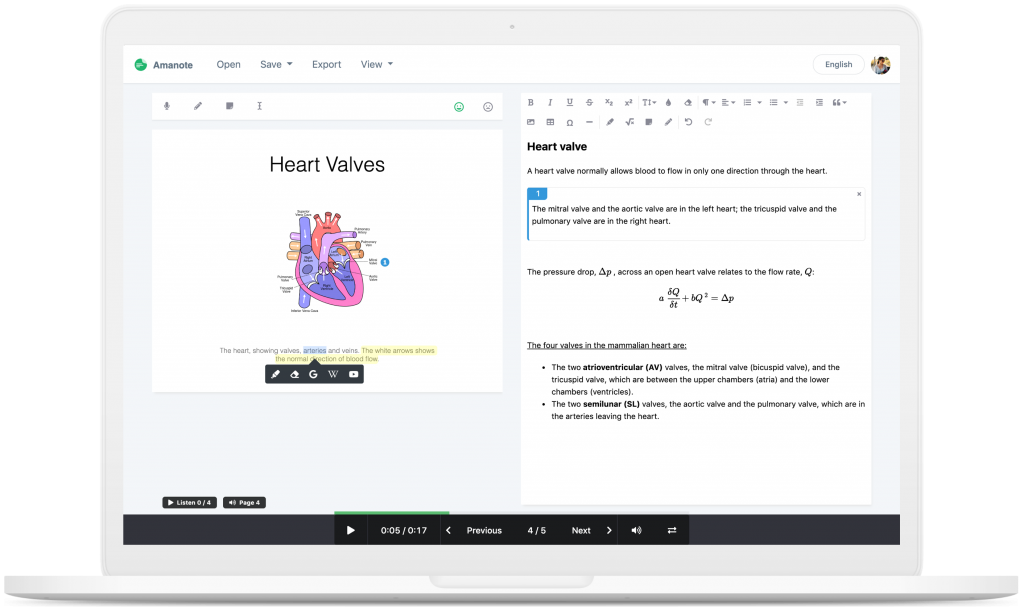Starting off at university can be quite an intimidating change! You will find that the way you studied and handled assignments in high school was very different from university and college requirements.
Notes are an essential part of higher education, read our article to know more. Your professors have a lot of knowledge to share but the way you capture and understand that depends on your note-taking methods. Taking notes in today’s age requires no special skills, but rather a good tool and a little meticulous planning before the course!
Here are 6 tips to help you take better notes this academic season.
1. Use a good note-taking app
There are many note-taking apps and softwares but only a few have been developed specifically for students. Whether you are looking for the best app for Windows, or any other operating system, for a laptop or a tablet, Amanote is your best friend <3
Amanote is one such note-taking app that’s helping higher ed students all across the world. The app allows you to take notes, structure them and link them to your course material (slides, syllabi, etc.) very easily. Amanote has many useful features for helping higher ed students to increase their productivity and to improve their study method.

For instance, a little feature that can have a great impact on your efficiency is the one that tracks the time spent on each slide – it helps you ascertain the importance of each one.
A good note-taking app like this can save you a lot of time and could significantly increase your productivity. You don’t waste paper, which is also eco-friendly. So, it is good for both you and the environment.
2. Focus on the cues
It is not possible to write everything during a lecture. How then do you make sure that you have taken down the most important parts of the lecture?
Look for certain cues. Often when a teacher is delivering a lecture, there are certain signs of emphasis which you should be able to identify. Some of these signs could be:
- If the professor repeats a point
- If he or she stresses on a word or term
- Words written on the board
- Things that the professor says you need to remember
If you are new to the class, it still shouldn’t take much time to identify the pattern. Once you’ve done that, you can take down notes at these signposts instead of trying to cover the entire lecture.
With Amanote, you can also tag a specific page of the course material as important or as a page that the professor has skipped. This is totally time-saving during your study of the course!
3. Record the lecture if allowed
Some students are sometimes so focused on their note-taking that they find it difficult to understand the professor. As explained earlier, it is crucial to take notes of the key elements but it can be counterproductive to take note of everything the professor says.
If you are too afraid to miss something or if you have difficulties taking notes while listening and understanding, you can record the lecture. Thus, you will have the opportunity to better focus on the important elements later when at home. When you’re revising, if you find that you don’t understand a certain passage, you can go and listen to that passage again.
When you record a lecture with Amanote, the app synchronizes the professor’s voice with the corresponding slide. A button “Listen” appears below each page/slide of the course material. So, you just have to click on that button to listen to the explanations corresponding to the current page. This feature is a considerable time saver!

In most countries, it’s allowed to record an academic lesson as long as you keep the recording exclusively for your personal usage and you don’t share it. Out of respect for the professor, it’s always nice to tell him or her that you are going to record the lesson.
4. Highlight and underline important points
Highlighting and underlining key points in your lecture notes make them stand out. It makes things much easier for you when you sit down to study from your notes later.
With Amanote you can highlight and underline your notes, as well as your course material!
5. Go to class prepared
Being prepared for a lecture can help you more than you think! When you know what the professor is going to discuss in class and have some idea of which parts are the most important, note-taking becomes more streamlined. So, do the reading of your course materials and get familiar with the topic before the class!
6. Use abbreviations where possible
There is always scope to shorten words when you are taking notes. Words that can be abbreviated without changing the meaning or context must be shortened to save you time and increase your speed.
For instance, writing w/o instead of without or i/p instead of input. These may not always be official abbreviations, but as long as you know what they mean you’re good to go.
You can do it!



